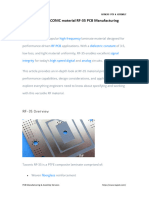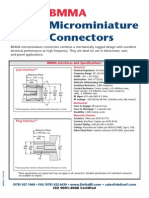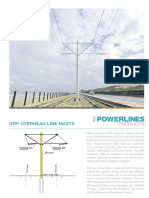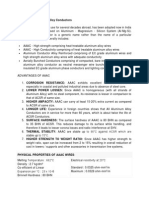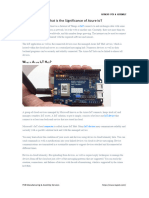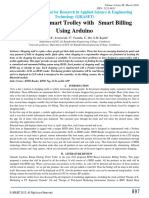What Is The Difference Between SMA and SMC Connectors
What Is The Difference Between SMA and SMC Connectors
Uploaded by
jackCopyright:
Available Formats
What Is The Difference Between SMA and SMC Connectors
What Is The Difference Between SMA and SMC Connectors
Uploaded by
jackOriginal Description:
Original Title
Copyright
Available Formats
Share this document
Did you find this document useful?
Is this content inappropriate?
Copyright:
Available Formats
What Is The Difference Between SMA and SMC Connectors
What Is The Difference Between SMA and SMC Connectors
Uploaded by
jackCopyright:
Available Formats
RAYMING PCB & ASSEMBLY
What is the difference between SMA and SMC connectors?
SMA and SMC connectors are two common radio frequency (RF)
coaxial connector styles used in telecommunications, test equipment,
aerospace, defense, and other microwave applications.
Both connector types provide excellent electrical performance at
microwave and millimeter wave frequencies, but they have some distinct
differences in their design and usage. Understanding these differences
helps engineers select the right option for their specific application and
performance requirements.
This comprehensive guide examines the key similarities and differences
between SMA and SMC connectors in terms of design, performance,
applications, standards and more.
Table of Contents
SMA Connectors Overview
SMA (SubMiniature version A) connectors were introduced in the 1960s as
a smaller alternative to Type N and C connectors used at the time. The
SMA uses a snap-on coupling mechanism and offers broadband
performance up to 18 GHz in some configurations.
PCB Manufacturing & Assembly Services https://www.raypcb.com/
RAYMING PCB & ASSEMBLY
Key Features
Compact threaded interface with snap-on coupling nut
Designed for semi-rigid and flexible cables
Widely used with test equipment, RF systems, microwave systems
Provides DC-18 GHz frequency range typically
Available in 50 ohm impedance
Robust mechanical design
Variants like reverse polarity SMA (RP-SMA)
SMA Connector
Where SMA Connectors are Used
SMA connectors are very popular for lower frequency microwave
applications including:
Test and measurement equipment
Telecommunication equipment
Aerospace and military systems
Antennas
Medical devices
General purpose RF and microwave component interconnections
PCB Manufacturing & Assembly Services https://www.raypcb.com/
RAYMING PCB & ASSEMBLY
They are ideal for applications not requiring the ruggedness or precision
of precision connectors. SMA strikes a good balance between
performance, cost, and ease of use.
Request PCB Manufacturing & Assembly Quote
SMC Connectors Overview
SMC (SubMiniature type C) connectors were introduced in the 1980s as a
smaller, higher performance alternative to SMA connectors. SMC uses a
threaded coupling interface and offers excellent broadband performance
to 26 GHz.
Key Features
Lightweight threaded coupling interface
Designed for semi-rigid cables
PCB Manufacturing & Assembly Services https://www.raypcb.com/
RAYMING PCB & ASSEMBLY
Stable performance to 26+ GHz
Broadband impedance of 50 ohms
Precision machined parts
Very low reflection coefficients
Attenuation comparable to 2.92mm connectors
Used for critical microwave connections
SMC Connector
Where SMC Connectors are Used
SMC connectors are well suited for high performance microwave
applications including:
Aerospace and defense systems
Satellite communications
Test instrumentation
Microwave radio links
High speed data transmission
Laboratory equipment
Microwave component interfacing
Their precision and repeatability make them ideal for measurement,
production, and field use in demanding environments.
PCB Manufacturing & Assembly Services https://www.raypcb.com/
RAYMING PCB & ASSEMBLY
SMA vs SMC Comparison
Now let’s look closely at how the two connector styles differ across various
attributes:
Parameter SMA Connector SMC Connector
Frequency range DC – 18 GHz DC – 26 GHz+
Impedance 50 ohms 50 ohms
Connector interface Threaded coupling nut Threaded coupler
Coupling nut material Nickel plated brass Stainless steel
Dielectric PTFE PTFE
Body styles Straight, bulkhead, jack, panel mount Straight, bulkhead
Durability 500 mating cycles 500+ mating cycles
RF leakage Good to 12 GHz Excellent to 18 GHz
Intermateability Connects with most SMA Primarily mates with SM
Cost Low cost Higher cost
Return loss Around -26 dB at 10 GHz -30 dB at 10 GHz
Repeatability Moderate Very high
Size Larger diameter More compact
Weight Heavier Lighter
PCB Manufacturing & Assembly Services https://www.raypcb.com/
RAYMING PCB & ASSEMBLY
As the table illustrates, SMC offers better electrical performance thanks to
its precision design but at a higher cost and lower intermateability than
SMA. Key differences are examined in more detail below.
Frequency Range
The SMA connector is intended for operation up to 18 GHz, while SMC
provides excellent performance to 26 GHz and beyond. So for microwave
applications above 18 GHz, the SMC is a better choice. Both connectors
work very well at lower microwave frequencies.
Impedance
SMA and SMC connectors both provide 50 ohm coaxial impedance for
matting with cables and components. This matches common RF system
impedance.
Connector Interface
SMA uses a threaded coupling nut that snaps onto the receptacle so it can
rotate independently. SMC utilizes a threaded coupler that engages
directly with the receptacle interface.
This difference means SMA connectors tend to be easier to thread
together, while SMC achieves better centering and microwave
performance.
PCB Manufacturing & Assembly Services https://www.raypcb.com/
RAYMING PCB & ASSEMBLY
Coupling Nut Material
On SMA connectors the coupling nut is nickel plated brass. SMC uses
passivated stainless steel for the coupler nut,
improving corrosion resistance. Stainless steel also has less mass,
reducing connector weight.
Dielectric Material
Both connector styles rely on PTFE (polytetrafluoroethylene) for the
insulator dielectric material. PTFE provides excellent electrical properties
at microwave frequencies along with chemical and temperature
resistance.
Body Styles
SMA is available in a wider range of body configuration including straight,
bulkhead, jack, panel mount and more. SMC tends to be offered in just
straight and bulkhead connector versions.
Durability
The SMA and SMC are rated for approximately 500 mating cycles before
performance degradation. This assumes proper mating and unmating
procedures are followed. SMC provides a little better cycle life on average.
PCB Manufacturing & Assembly Services https://www.raypcb.com/
RAYMING PCB & ASSEMBLY
RF Leakage
SMC provides lower RF leakage than SMA, particularly at higher
frequencies. This improves signal integrity and measurement accuracy. At
10 GHz SMC leakage is around -65 dB versus -55 dB for SMA.
Intermateability
Due to their different interfaces, SMA and SMC connectors are primarily
intended to mate with same type. However, SMA connectors have some
intermateability with Type N and 3.5mm connectors, while SMC
connectors only reliably mate with other SMCs.
Cost
SMC connectors cost significantly more than SMA connectors, often 2-3
times as much. This is due to tighter tolerances and precision
manufacturing of SMC components.
Return Loss
Return loss describes how much signal power is reflected back due to
impedance mismatches in the connector. SMC provides excellent return
loss of -30 dB or better at 10 GHz. SMA return loss is around -26 dB
typically.
PCB Manufacturing & Assembly Services https://www.raypcb.com/
RAYMING PCB & ASSEMBLY
Repeatability
The SMC’s precision threaded interface allows greater mating repeatability
than SMA. This ensures consistent performance over many
connect/disconnect cycles.
Size
SMC connectors have a smaller diameter and take up less space than SMA
connectors. SMC’s compactness provides more connector density in
multi-connector assemblies.
Weight
Related to their size differences, SMC connectors are appreciably lighter
than SMA models. This provides weight savings which are important in
aerospace and portable applications.
Request PCB Manufacturing & Assembly Quote
SMA and SMC Standards
PCB Manufacturing & Assembly Services https://www.raypcb.com/
RAYMING PCB & ASSEMBLY
SMA and SMC connectors are standardized by different organizations:
SMA – MIL-PRF-39012, IEC 61169-42
SMC – MIL-PRF-39012, IEC 61169-65
These specifications define the critical dimensions, materials, electrical
properties, environmental testing levels and other requirements that
connectors must meet to be compliant.
Using connectors that adhere to the standards ensures interchangeability
between suppliers and reliability in the field. The standards documents
provide all the key technical details needed for manufacturers and users.
Typical Applications of SMA and SMC
SMA Applications
SMA connectors are very commonly used for:
PCB Manufacturing & Assembly Services https://www.raypcb.com/
RAYMING PCB & ASSEMBLY
Antenna connections
RF signal routing in wireless communications equipment
Interfacing test equipment like signal generators, spectrum
analyzers, power meters and vector network analyzers
Microwave component evaluation and prototyping
General purpose coaxial jumpers and adapters
Lower frequency aerospace and defense electronics
Biomedical instruments like MRI machines
SMC Applications
SMC connectors are an excellent choice for:
High performance aerospace and defense communications
Fast data collection systems
Microwave instrumentation and metrology
High frequency antenna feeds
Satellite payloads
Microwave radio links
Calibrated measurement port extensions
Research labs and test facilities
Microwave component characterization
PCB Manufacturing & Assembly Services https://www.raypcb.com/
RAYMING PCB & ASSEMBLY
So SMCs are often found where accuracy, precision, and repeatability are
paramount.
SMA and SMC Cable Assemblies
SMA and SMC connectors are frequently used on coaxial cable assemblies
and adapters for interfacing equipment. Common cable types assembled
with the connectors include:
Cable Type Description SMA Use SMC Use
Semi-rigid Solid inner conductor with dielectric/outer Common Most common
coax conductor tubing
PCB Manufacturing & Assembly Services https://www.raypcb.com/
RAYMING PCB & ASSEMBLY
Cable Type Description SMA Use SMC Use
Flexible Center wire, dielectric, braided outer conductor Common Moderate use
coax
Waveguide Rectangular or circular metallic tube Via adapters Via adapters
Multi-cable Multiple coaxial lines bundled together Yes Limited use
Semi-rigid cables are the preferred medium for both connectors. Flexible
coax is more often used with SMA. Custom cable lengths, connector
orientation, and configurations can be fabricated for various applications.
Choosing Between SMA and SMC
So when selecting between SMA and SMC connectors, consider the
following:
Frequency Range – For applications over 18 GHz, SMC is likely the better
choice. Under 18 GHz, either will work well.
Precision – If repeatability and accuracy under mating/unmating is critical,
opt for SMC.
Performance – SMC provides lower reflection, leakage, and loss, so for
demanding applications it is preferred.
Cost – SMA costs less than SMC, so use SMA if budget is a major factor and
performance requirements are moderate.
Size – If a compact, lightweight connector is required, SMC is the smaller
choice.
PCB Manufacturing & Assembly Services https://www.raypcb.com/
RAYMING PCB & ASSEMBLY
Environment – SMC offers better corrosion resistance for outdoor and
humid applications.
Both connector families have proven reliability though, so performance
tradeoffs, cost, and other factors specific to the application should all be
weighed.
Conclusion
SMA and SMC connectors provide interconnect solutions across DC to 26+
GHz frequencies, with some important differences. SMA offers a balance
of modest size, weight, cost and performance. SMC provides top-tier
electrical performance for critical microwave connections, with tighter
tolerances and somewhat higher cost.
PCB Manufacturing & Assembly Services https://www.raypcb.com/
RAYMING PCB & ASSEMBLY
Engineers have the luxury of choosing between two excellent coaxial
connector platforms in SMA and SMC. By understanding their capabilities,
limitations, and tradeoffs, informed design decisions can be made
matching the connector technology to the demands of the application.
Both SMA and SMC will continue serving the RF and microwave
community well into the future.
Frequently Asked Questions
Here are some common FAQs about SMA and SMC connectors:
Q: Can SMA and SMC connectors be mated together?
A: Direct mating is not recommended. The different interfaces can cause
damage. Adapters can allow interconnection in certain cases.
Q: How are SMA and SMC connectors identified when disconnected?
A: SMA has a larger nut with knurled brass surface. SMC uses a stainless
steel threaded coupler. Visual markings also differentiate.
Q: What causes wear out in SMA and SMC connectors?
A: Debris entering the precision interface, contamination, exposure to
weather extremes, improper mating, excessive mating cycles, etc. Proper
care improves longevity.
PCB Manufacturing & Assembly Services https://www.raypcb.com/
RAYMING PCB & ASSEMBLY
Q: What torque should be used when tightening SMA and SMC
connectors?
A: SMA is typically torqued to 4-5 in-lbs. SMC uses a lighter 0.9 in-lbs
torque to avoid deforming precision threads.
Q: Can SMA or SMC connectors be used above 40 GHz?
A: Performance declines dramatically above 26 GHz for SMC and 18 GHz
for SMA as coaxial modes are cut off. Other connector styles like 2.92mm
are better beyond 40 GHz.
Related Posts:
1. What are the different types of connectors for PCB?
2. What to Look For in Molex FPC Connectors
3. Understanding the integration between USB 3.1 Gen 2 and FPC
Connectors
4. What’s the Difference between EMI EMS and EMC ?
https://www.raypcb.com/sma-connector-pcb/
PCB Manufacturing & Assembly Services https://www.raypcb.com/
You might also like
- Telecommunications Distribution Methods Manual (TDMM), 13th EditionDocument88 pagesTelecommunications Distribution Methods Manual (TDMM), 13th EditionLeslie Hicks100% (2)
- Type 183 AssemblY Instruction ManualDocument20 pagesType 183 AssemblY Instruction ManualMatias YanzonNo ratings yet
- L-3 Ocean Systems AQS-18 (V) - 5Document2 pagesL-3 Ocean Systems AQS-18 (V) - 5Shiva Singh100% (1)
- Automated Broad and Narrow Band Impedance Matching for RF and Microwave CircuitsFrom EverandAutomated Broad and Narrow Band Impedance Matching for RF and Microwave CircuitsNo ratings yet
- 2280-Motorola Maxtrac 100-300 User ManualDocument37 pages2280-Motorola Maxtrac 100-300 User ManualKo AzaniNo ratings yet
- Intermateability Microwave Journal PinoDocument5 pagesIntermateability Microwave Journal Pinopredrag_miletic_1No ratings yet
- RF PCB Design Guidelines You Must KnowDocument13 pagesRF PCB Design Guidelines You Must KnowjackNo ratings yet
- Coaxial ConnectorsDocument3 pagesCoaxial ConnectorsHeesoo LeeNo ratings yet
- What Is Ro4003c Dielectric ConstantDocument11 pagesWhat Is Ro4003c Dielectric ConstantjackNo ratings yet
- How To Control Flex PCB ImpedanceDocument10 pagesHow To Control Flex PCB ImpedancejackNo ratings yet
- Full Introduction About Antenna Types and PCB MaterialsDocument40 pagesFull Introduction About Antenna Types and PCB MaterialsjackNo ratings yet
- Avago Layout GuideDocument8 pagesAvago Layout GuideTran Ba QuynhNo ratings yet
- How To Create A Planar Transformer PCB DesignDocument20 pagesHow To Create A Planar Transformer PCB DesignjackNo ratings yet
- What Is PCB Edge PlatingDocument23 pagesWhat Is PCB Edge PlatingjackNo ratings yet
- How To Choose The Right PCB ResistorDocument15 pagesHow To Choose The Right PCB ResistorjackNo ratings yet
- Guidelines For RF PCB Design and Microwave Materials OptionsDocument15 pagesGuidelines For RF PCB Design and Microwave Materials OptionsjackNo ratings yet
- What Is Wire BondingDocument27 pagesWhat Is Wire BondingjackNo ratings yet
- What Is Aluminum Oxide PCB (Al2O3)Document12 pagesWhat Is Aluminum Oxide PCB (Al2O3)jackNo ratings yet
- ENG CS 1307191 MMCX Connectors 0307Document4 pagesENG CS 1307191 MMCX Connectors 0307muhammadsyam44No ratings yet
- What Is Rogers 6035htc PCBDocument11 pagesWhat Is Rogers 6035htc PCBjackNo ratings yet
- Cable Group ListingDocument6 pagesCable Group ListingEzhar Savero RomanNo ratings yet
- 20xx-HIGH DENSITY COAXIAL INTERCONNECTDocument8 pages20xx-HIGH DENSITY COAXIAL INTERCONNECTketab_doostNo ratings yet
- What Is Rogers Ro4003c MaterialDocument6 pagesWhat Is Rogers Ro4003c MaterialjackNo ratings yet
- What Is Rogers RTDuroid 5880LZ MaterialDocument8 pagesWhat Is Rogers RTDuroid 5880LZ MaterialjackNo ratings yet
- What Is High Speed PCB DesignDocument13 pagesWhat Is High Speed PCB DesignjackNo ratings yet
- Types of SMD Components and How To Identify ThemDocument9 pagesTypes of SMD Components and How To Identify ThemjackNo ratings yet
- What Is Duroid PCBDocument9 pagesWhat Is Duroid PCBjackNo ratings yet
- Antenna Design and RF Layout Guidelines You Must KnowDocument26 pagesAntenna Design and RF Layout Guidelines You Must KnowjackNo ratings yet
- How To Design PCB Trace Spacing and WidthDocument15 pagesHow To Design PCB Trace Spacing and WidthjackNo ratings yet
- Full Intruction About Rogers Circuit Board MaterialDocument16 pagesFull Intruction About Rogers Circuit Board MaterialjackNo ratings yet
- What Is A PCB Screw TerminalFunctions, Types and Install MethodsDocument16 pagesWhat Is A PCB Screw TerminalFunctions, Types and Install MethodsjackNo ratings yet
- All About TACONIC Material RF-35 PCB ManufacturingDocument17 pagesAll About TACONIC Material RF-35 PCB ManufacturingjackNo ratings yet
- Important Types and Principle of 2.4K ResistorDocument8 pagesImportant Types and Principle of 2.4K ResistorjackNo ratings yet
- 500W, Class E 27.12 MHZ Amplifier Using A Single Plastic MosfetDocument7 pages500W, Class E 27.12 MHZ Amplifier Using A Single Plastic MosfetAndre Vitor DobrychtopNo ratings yet
- What Is Rogers Ro3003g2 PCBDocument12 pagesWhat Is Rogers Ro3003g2 PCBjackNo ratings yet
- Models 7004 & 7005 P C U C S DC To 40.0 GHZ: Sma Type N TNC Gpc-7 3.5Mm 2.92Mm 2.4MmDocument5 pagesModels 7004 & 7005 P C U C S DC To 40.0 GHZ: Sma Type N TNC Gpc-7 3.5Mm 2.92Mm 2.4MmNghiem Xuan AnhNo ratings yet
- What Is Rogers Tmm6 PCBDocument13 pagesWhat Is Rogers Tmm6 PCBjackNo ratings yet
- Prysmian Separable Connectors v1.03Document12 pagesPrysmian Separable Connectors v1.03Muhammad SyaifulhaqNo ratings yet
- What Is Rogers RO3010 PCBDocument8 pagesWhat Is Rogers RO3010 PCBjackNo ratings yet
- How To Design A PCB For High FrequencyDocument27 pagesHow To Design A PCB For High FrequencyjackNo ratings yet
- Printed Circuit Board TechniquesDocument6 pagesPrinted Circuit Board TechniquesA. VillaNo ratings yet
- What Is Buried Via PCBDocument10 pagesWhat Is Buried Via PCBjackNo ratings yet
- A Quick Guide To Rogers AD300D LaminatesDocument3 pagesA Quick Guide To Rogers AD300D LaminatesjackNo ratings yet
- 250 GHZ Sige-Bicmos Cascaded Single-Stage Distributed AmplifierDocument4 pages250 GHZ Sige-Bicmos Cascaded Single-Stage Distributed AmplifierAli HattabNo ratings yet
- Design of A CMOS Tapered Cascaded Multistage Distributed AmplifierDocument10 pagesDesign of A CMOS Tapered Cascaded Multistage Distributed Amplifierindresh.vermaNo ratings yet
- 37smss1 CB Sf6 r3Document33 pages37smss1 CB Sf6 r3JagadishNo ratings yet
- AMPHENOL Series 3Document36 pagesAMPHENOL Series 3PTCNo ratings yet
- Copperweld Grounding Wire & StrandDocument4 pagesCopperweld Grounding Wire & StrandNelson RuizNo ratings yet
- Microminiature Connectors: Connect HereDocument2 pagesMicrominiature Connectors: Connect HereRO-AM-BDNo ratings yet
- GRP MastDocument2 pagesGRP MastMaryam vafaee.nNo ratings yet
- Application Note # 51 Application Guide To RF Coaxial Connectors and CablesDocument6 pagesApplication Note # 51 Application Guide To RF Coaxial Connectors and Cablesapi-3698488No ratings yet
- What Is Blind Via PCBDocument10 pagesWhat Is Blind Via PCBjackNo ratings yet
- L1-CHE-SPE-059 Hard-Drawn Copper Solid Dropper Wire 21.15mm 2Document6 pagesL1-CHE-SPE-059 Hard-Drawn Copper Solid Dropper Wire 21.15mm 2CK TangNo ratings yet
- CCTV Camera Rigid Flex PCB Circuit Board DesignDocument13 pagesCCTV Camera Rigid Flex PCB Circuit Board DesignjackNo ratings yet
- Datasheet QS2000E 93-AS 620-1Document3 pagesDatasheet QS2000E 93-AS 620-1Marcela JiménezNo ratings yet
- What Is The Difference Between A Decoupling Capacitor and A Bypass CapacitorDocument16 pagesWhat Is The Difference Between A Decoupling Capacitor and A Bypass CapacitorjackNo ratings yet
- How Do You Calculate The PCB Trace ResistanceDocument15 pagesHow Do You Calculate The PCB Trace ResistancejackNo ratings yet
- What Is Rogers RT Duroid 6002 For PCBDocument10 pagesWhat Is Rogers RT Duroid 6002 For PCBjackNo ratings yet
- What Is PCB Copper FoilDocument14 pagesWhat Is PCB Copper FoiljackNo ratings yet
- A Comprehensive Comparison of Stripline vs. MicrostripDocument10 pagesA Comprehensive Comparison of Stripline vs. MicrostripjackNo ratings yet
- AAAC Advantages Over ACSRDocument2 pagesAAAC Advantages Over ACSRVivek KumarNo ratings yet
- SMA Connector SeriesDocument26 pagesSMA Connector SeriesCmpterRFNo ratings yet
- High-Performance D/A-Converters: Application to Digital TransceiversFrom EverandHigh-Performance D/A-Converters: Application to Digital TransceiversNo ratings yet
- Why You Should Choose The Shengyi S7439G PCB MaterialDocument5 pagesWhy You Should Choose The Shengyi S7439G PCB MaterialjackNo ratings yet
- Why The Arlon 49N PCB Material Is Useful in High Temperature or High Performance ApplicationsDocument4 pagesWhy The Arlon 49N PCB Material Is Useful in High Temperature or High Performance ApplicationsjackNo ratings yet
- Why OEM Circuit Boards Are Ideal For Use in Several ApplicationsDocument6 pagesWhy OEM Circuit Boards Are Ideal For Use in Several ApplicationsjackNo ratings yet
- Xilinx XAZU2EG-1SBVA484I Fpga ApplicationDocument5 pagesXilinx XAZU2EG-1SBVA484I Fpga ApplicationjackNo ratings yet
- Why Is The Panasonic R-F705S Useful For Mobile and Automotive ProductsDocument4 pagesWhy Is The Panasonic R-F705S Useful For Mobile and Automotive ProductsjackNo ratings yet
- Who Are The Leading Electrical Coil ManufacturersDocument5 pagesWho Are The Leading Electrical Coil ManufacturersjackNo ratings yet
- Why A PCB Ground Plane Is Crucial For PCB FunctioningDocument3 pagesWhy A PCB Ground Plane Is Crucial For PCB FunctioningjackNo ratings yet
- Why 3D Print PCBs Matter in Today's Electronics ProductionDocument4 pagesWhy 3D Print PCBs Matter in Today's Electronics ProductionjackNo ratings yet
- Why Non Recurring Engineering Cost (NRE Charge) Is Important For Your PCBDocument4 pagesWhy Non Recurring Engineering Cost (NRE Charge) Is Important For Your PCBjackNo ratings yet
- Why Is The Home Energy Monitor ImportantDocument7 pagesWhy Is The Home Energy Monitor ImportantjackNo ratings yet
- What Is Xilinx Virtex-5 FPGADocument8 pagesWhat Is Xilinx Virtex-5 FPGAjackNo ratings yet
- Where Does The QuickLogic Eclipse FPGA Architecture Family Play A RoleDocument11 pagesWhere Does The QuickLogic Eclipse FPGA Architecture Family Play A RolejackNo ratings yet
- What Is The Significance of Home Electronics PCBDocument6 pagesWhat Is The Significance of Home Electronics PCBjackNo ratings yet
- What Is Xilinx XA6SLX75T-2FGG484I ChipDocument5 pagesWhat Is Xilinx XA6SLX75T-2FGG484I ChipjackNo ratings yet
- What Is Taconic TSM-DS3b PCBDocument7 pagesWhat Is Taconic TSM-DS3b PCBjackNo ratings yet
- Where To Buy Rogers RT Duroid 5880 LaminateDocument5 pagesWhere To Buy Rogers RT Duroid 5880 LaminatejackNo ratings yet
- What Is The Significance of ENIG Plating ThicknessDocument4 pagesWhat Is The Significance of ENIG Plating ThicknessjackNo ratings yet
- What Is Signal Integrity A Comprehensive OverviewDocument9 pagesWhat Is Signal Integrity A Comprehensive OverviewjackNo ratings yet
- What Is Xilinx Spartan-7 Its Datasheet and Reference DesignsDocument20 pagesWhat Is Xilinx Spartan-7 Its Datasheet and Reference DesignsjackNo ratings yet
- What Is The Significance of IOT in AgricultureDocument8 pagesWhat Is The Significance of IOT in AgriculturejackNo ratings yet
- What Is The Melting Point of SolderDocument4 pagesWhat Is The Melting Point of SolderjackNo ratings yet
- What Is The Difference Between ARM and FPGA ProcessorsDocument9 pagesWhat Is The Difference Between ARM and FPGA ProcessorsjackNo ratings yet
- What Is The Purpose and Applications of A PCB MotherboardDocument4 pagesWhat Is The Purpose and Applications of A PCB MotherboardjackNo ratings yet
- What Is The Significance of Azure IoTDocument6 pagesWhat Is The Significance of Azure IoTjackNo ratings yet
- What Is Through Hole PCB AssemblyDocument12 pagesWhat Is Through Hole PCB AssemblyjackNo ratings yet
- What Is The Difference Between Clean Flux and No Clean Flux Off PCBDocument13 pagesWhat Is The Difference Between Clean Flux and No Clean Flux Off PCBjackNo ratings yet
- What Is Thermal Consideration in PCB DesignDocument6 pagesWhat Is Thermal Consideration in PCB DesignjackNo ratings yet
- What Is The Difference Between FFC Connector and FPC ConnectorDocument14 pagesWhat Is The Difference Between FFC Connector and FPC ConnectorjackNo ratings yet
- What Is SMT Soldering Process Step by StepDocument12 pagesWhat Is SMT Soldering Process Step by StepjackNo ratings yet
- What Is Xilinx Kintex UltraScale UltraScale+Document8 pagesWhat Is Xilinx Kintex UltraScale UltraScale+jackNo ratings yet
- Pcm55Saw: Installation and Operation ManualDocument8 pagesPcm55Saw: Installation and Operation ManualJJ RRNo ratings yet
- User Manual: Manufactured by ItalyDocument24 pagesUser Manual: Manufactured by ItalyQuive CarlosNo ratings yet
- Guia ManualDocument21 pagesGuia ManualStartup BotNo ratings yet
- ResearchProposal IT20209698Document3 pagesResearchProposal IT20209698hayatasil19No ratings yet
- Automated Smart Trolley With Smart Billing Using ArduinoDocument6 pagesAutomated Smart Trolley With Smart Billing Using ArduinoRohan MNo ratings yet
- Advantages and Applications of The Rogers AD350ADocument3 pagesAdvantages and Applications of The Rogers AD350AjackNo ratings yet
- Nnh4-65B-R6: 12-Port Sector Antenna, 4X 698-896 and 8X 1695-2360 MHZ, 65° HPBW, 6X RetDocument5 pagesNnh4-65B-R6: 12-Port Sector Antenna, 4X 698-896 and 8X 1695-2360 MHZ, 65° HPBW, 6X RetPérez Mendoza Diana LauraNo ratings yet
- Digital CommunicationDocument19 pagesDigital Communicationnimish kambleNo ratings yet
- Narrow-Band Switched-Capacitor Bandpass FiltersDocument16 pagesNarrow-Band Switched-Capacitor Bandpass FiltersEvelynlima02No ratings yet
- Analog Communication - MultiplexingDocument4 pagesAnalog Communication - MultiplexingcdrupwestNo ratings yet
- Soal Explanation & PassiveDocument5 pagesSoal Explanation & PassiveRayanggaNo ratings yet
- Ds 5510 5516 0610Document2 pagesDs 5510 5516 0610frdnNo ratings yet
- Lightning Protection and Filter Design For The Power Supply System of Communications VehicleDocument6 pagesLightning Protection and Filter Design For The Power Supply System of Communications VehicleTareq AzizNo ratings yet
- Unit3 OpampDocument23 pagesUnit3 OpampPriyanshu yadavNo ratings yet
- Handbook For Marine Radio Communication: - InformaDocument29 pagesHandbook For Marine Radio Communication: - InformaClarence PieterszNo ratings yet
- Entel HT Series MarineDocument4 pagesEntel HT Series MarineDimitry SilinshNo ratings yet
- Return Loss and VSWR With Formula-01Document6 pagesReturn Loss and VSWR With Formula-01Adit HaqyNo ratings yet
- Fire Alarm PresentationDocument45 pagesFire Alarm PresentationRahul Srivastava86% (7)
- Microwave Devices: ObjectivesDocument7 pagesMicrowave Devices: Objectivesba beshaNo ratings yet
- Data and Ip Lecture NotesDocument144 pagesData and Ip Lecture NotesTinotenda ChakareNo ratings yet
- Week 11 Assignment Solution PDFDocument8 pagesWeek 11 Assignment Solution PDFSUKUMAR T ITNo ratings yet
- PSP987 Bulu Barumun - PSP643 Sibuhuan, MLE-7HP To MLTN-7X, 0.6 To 1.2DP (New), 16E1 To 200 MBPS, 1+1HSDocument8,959 pagesPSP987 Bulu Barumun - PSP643 Sibuhuan, MLE-7HP To MLTN-7X, 0.6 To 1.2DP (New), 16E1 To 200 MBPS, 1+1HSOkas PaskalNo ratings yet
- The NASA Game by WWW - Nasa.govDocument2 pagesThe NASA Game by WWW - Nasa.govAlmas TNo ratings yet
- Radio Navigation: Use of VOR: IFR Briefing I3Document75 pagesRadio Navigation: Use of VOR: IFR Briefing I3Sandeep JangraNo ratings yet
- 5 Digital BasebandDocument20 pages5 Digital BasebandshimeNo ratings yet
- LAB 2 Exercise 1 2 AnswerDocument15 pagesLAB 2 Exercise 1 2 AnswerSharmine Ong YSNo ratings yet
- CRO ManualDocument79 pagesCRO ManualElakkiya Selvaraj100% (1)































